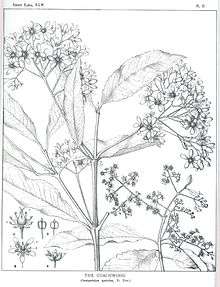Ceratopetalum apetalum
Ceratopetalum apetalum, the coachwood, scented satinwood or tarwood, is a medium-sized hardwood tree, straight-growing with smooth, fragrant, greyish bark. It is native to eastern Australia in the central and northern coastal rainforests of New South Wales and southern Queensland, where is often found on poorer quality soils in gullies and creeks and often occurs in almost pure stands. C. apetalum is one of 8 species of Ceratopetalum occurring in eastern Australia, New Guinea, New Britain and various islands in the same region.[2]
| Coachwood | |
|---|---|
 | |
| Coachwood at Nymboi-Binderay National Park | |
 | |
| Ceratopetalum apetalum | |
| Scientific classification | |
| Kingdom: | Plantae |
| Clade: | Tracheophytes |
| Clade: | Angiosperms |
| Clade: | Eudicots |
| Clade: | Rosids |
| Order: | Oxalidales |
| Family: | Cunoniaceae |
| Genus: | Ceratopetalum |
| Species: | C. apetalum |
| Binomial name | |
| Ceratopetalum apetalum | |
| Synonyms[1] | |
| |
Taxonomy
George Caley collected the species, which was described by David Don in 1830.[3]
The common name of coachwood comes from its use in the building of coaches.[4]
Description
Coachwood usually grows to a height of 25 metres, with a trunk diameter of 90 cm.[4] however exceptional specimens can reach 40 metres tall and live for centuries. The stem has distinctive horizontal marks, or scars, which often encircle the trunk. Larger trees have short buttresses. The heartwood is attractive with a colour ranging from pale pink to pinkish-brown. The sapwood is not always distinguishable The grain is straight, finely textured and even. On the tangential face the wood is often highly figured. The wood has a characteristic caramel odour.
Uses
Its timber is light and easily worked. It is used for flooring, furniture and cabinetwork, interior fittings, turnery, gun stocks, wood carving, veneers as well as spars and masts for boats. Courtroom number three of The High Court of Australia is beautifully and completely furnished with coachwood timber.[5]
References
- The Plant List: A Working List of All Plant Species, retrieved 21 August 2016
- Gandolfo, María A.; Hermsen, Elizabeth J. (2017). "Ceratopetalum(Cunoniaceae) fruits of Australasian affinity from the early Eocene Laguna del Hunco flora, Patagonia, Argentina". Annals of Botany: mcw283. doi:10.1093/aob/mcw283. PMC 5571373.
- Don, David (1830). "Monography of the family of plants called Cunoniaceae". The Edinburgh New Philosophical Journal. 9: 94.
- Boland, Douglas J.; Brooker, M. I. H.; Chippendale, G. M.; McDonald, Maurice William (2006). Forest trees of Australia. Collingwood, Victoria: CSIRO Publishing. p. 94. ISBN 0-643-06969-0.
- "The Building: Courtroom 3". The High Court of Australia. 2010. Retrieved 26 November 2016.
- Floyd, A.G., Rainforest Trees of Mainland South-eastern Australia, Inkata Press 1989, ISBN 0-909605-57-2